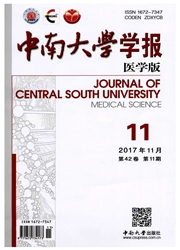

 中文摘要:
中文摘要:
目的:研究不明原因早期癫癎性脑病(EEEs)患儿临床特点,并进行全基因组拷贝数变异检测,寻找致病性微缺失/重复。方法收集2012年7月至2013年4月60例不明原因EEEs患儿临床资料进行分析,采集患儿及其父母样本,应用SNP array技术对患儿进行全基因组拷贝数变异检测,结合荧光原位杂交技术进行验证及父母来源分析,寻找可疑致病性拷贝数变异。结果60例不明原因EEEs患儿诊断婴儿痉挛症34例,大田原综合征3例,婴儿严重肌阵挛性癫癎3例,余20例分型不明确。77%患儿伴有中重度智力障碍。颅脑影像学检查提示35%患儿脑发育不良或脑萎缩。54例患儿中,17%有小头畸形。经治疗28例患儿癫癎控制,16例未控制,5例死亡,1例失访。全基因组拷贝数变异分析结果:5人发现7个致病性或可疑致病性拷贝数变异。结论不明原因EEEs临床表现多样,预后差。全基因组拷贝数变异分析可发现致病性或可疑致病性拷贝数变异,丰富癫癎脑病基因型数据库,促进对不明原因EEEs病因学的进一步认识,为患者家庭再生育的遗传咨询提供理论依据。
 英文摘要:
英文摘要:
Objective To study the clinical features of early-onset epileptic encephalopathies (EEEs) of unknown cause, and to identify pathogenic microdeletion/microduplication of EEEs by genome-wide analysis of copy number variations (CNVs). Methods The clinical data of 60 children diagnosed with unexplained EEEs between July 2012 and April 2013 were obtained and analyzed. Specimens were collected from the selected children and their parents. Single nucleotide polymorphism array was used to detect genome-wide CNVs, and lfuorescence in situ hybridization was performed to verify the results and analyze the source of the parents, further to identify suspected pathogenic CNVs of EEEs. Results Among the 60 children with unexplained EEEs, 34 were diagnosed with West syndrome, 3 with Ohtahara syndrome, 3 with Dravet syndrome, and 20 with unclassiifed EEEs. In total, 77%of the patients were associated with moderate to severe mental retardation. Head imaging test implied that 35% of the patients had brain dysplasia or astrophy. Among 54 patients, 17%showed microcephalus. After treatment, 28 patients had clinical seizures under control, 16 out of control, 5 dead, and 1 lost to follow-up. Genome-wide analysis of CNVs showed that 7 pathogenic or suspected pathogenic CNVs were present in 5 patients. Conclusions EEEs of unknown cause are associated with high phenotypic heterogeneity and poor prognosis. Genome-wide CNVs analysis can demonstrate pathogenic or suspected pathogenic CNVs. This research expands the gene bank of EEEs and improves the understanding about possible etiology of unexplained EEEs. The results provide a reference for genetic counseling regarding reproduction in the patient's family.
 同期刊论文项目
同期刊论文项目
 同项目期刊论文
同项目期刊论文
 期刊信息
期刊信息
